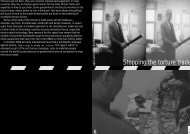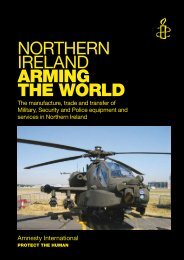CROWD CONTROL TECHNOLOGIES - Omega Research Foundation
CROWD CONTROL TECHNOLOGIES - Omega Research Foundation
CROWD CONTROL TECHNOLOGIES - Omega Research Foundation
You also want an ePaper? Increase the reach of your titles
YUMPU automatically turns print PDFs into web optimized ePapers that Google loves.
Department of Health. Committee on Toxicity, Mutagenicity, Carcinogenicity of Chemicals in Food, Consumer Products and the Environment<br />
(1999) Statement on 2-Chlorobenzylidene Malononitrile (CS) and CS Spray. September.<br />
143. Zekri, A.M.B., King, W.W.K., Yeung, R. and Taylor, W.R.J. (1995) Acute mass burns caused by o-chlorobenzylidene malononitrile (CS) tear<br />
gas. Burns. Vol. 21. No.8. pp 586-589.<br />
144. Sidell F. (1997) op.cit.<br />
145. McGregor, Glen. (2000) Ottawa Cops Pepper Spray Lawsuit. The Ottawa Citizen. 19th February.<br />
146. Hansard, 21 January 1977, col 330.<br />
147. For a more technical explanation of such performance calculation see US Department of Justice (1973) Multi-disciplinary technique for the evaluation of<br />
less-lethal weapons. Volume 1. July. U.S. military weapons research laboratories have used this approach to produce the empirical data used in this current study<br />
as a benchmark. These researchers note that such performance characteristics generally fall into two categories namely:- (i) those that determine the effect on the<br />
target if the target is hit (muzzle velocity, projectile weight and drag), and (ii) those that determine if the target is hit (accuracy and reliability). Similarly with<br />
chemical devices where the performance characteristics fall into the same two categories. However, the distinction between a )hit( and a )no-hit( is not as precise<br />
for chemical devices as compared with kinetic energy devices.<br />
148. Egner, D.O. et al (1973) A multi disciplinary technique for the evaluation of less lethal weapons Vol 1'. US Department of Justice.<br />
149. Hansard 28 March 2000. )The government have accepted recommendation 69 of the report of the Independent Commission on Policing (in Northern<br />
Ireland), that a research programme to find a less potentially lethal alternative to plastic baton rounds should be established. The issue is at present being actively<br />
considered and a decision on the way forward is expected in the near future.(<br />
Examples of secrecy include suppression of reports from the UKs Ordnance Board - the body that certifies weapons that can be used by the UK security forces;<br />
the UK Police Scientific Development Branch who have produced several reports on )Police Baton Round Equipment for the Police( (Police Scientific<br />
Development Branch Annual Report 92/93) and the Association of Chief Police Officers (ACPO) who produce the )Public Order Tactical Options Manual( for<br />
UK Police forces and have a central role in decisions on what equipment is used, for example their )ACPO Replacement Baton Gun Project Team( which led to<br />
the decision the deploy the Heckler and Koch weapon in the UK (Police Scientific Development Branch Annual Report 92/3) and also the review of plastic baton<br />
rounds which led to new guidelines being introduced in 1999.<br />
Although the UK government has published the name of the manufacturer of the weapon used in the UK (Her Majestys Inspector of Constabulary Annual Report<br />
1996/7, HMSO, UK.) it refuses, on national security grounds, to name the ammunition supplier or to publish tenders for training equipment (Minutes of the<br />
Select Committee on Administration http://www.publications.parliament.uk/pa/cm199899/cmselect/cmpubadm/821/821mem17.htm)<br />
lxxix




